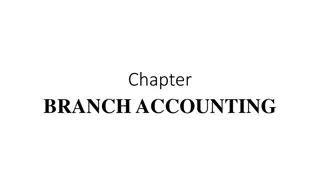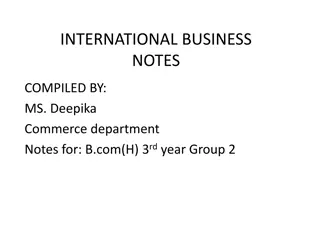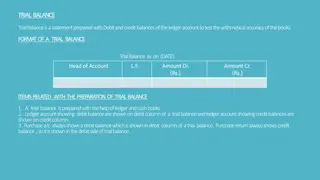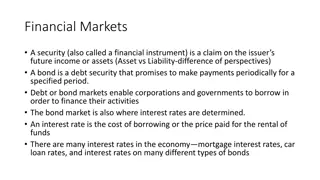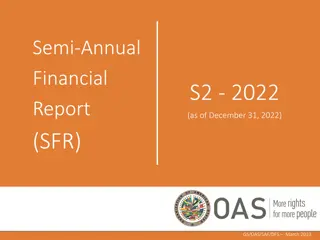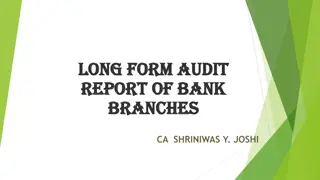Accounting for Foreign Branches: Converting Trial Balances and Exchange Rates
A foreign branch maintains its accounts in a foreign currency, requiring the head office to convert the trial balance into its own currency before finalizing accounts. Fixed and fluctuating exchange rates impact the conversion process, with specific rules for fixed assets, liabilities, and current assets/liabilities. Understanding the methods for converting foreign branch balances is crucial for accurate financial reporting.
Download Presentation

Please find below an Image/Link to download the presentation.
The content on the website is provided AS IS for your information and personal use only. It may not be sold, licensed, or shared on other websites without obtaining consent from the author. Download presentation by click this link. If you encounter any issues during the download, it is possible that the publisher has removed the file from their server.
E N D
Presentation Transcript
WELCOME Class: B.Com Part-1 Subject: Financial Accounting Topic: Branch Accounts Accounting for Foreign Branch 1 PREPARED BY DR. SHAHID IQBAL GUEST FACULTY Marwari college, darbhanga, Mobile no. and whatsup no. : 7004160257 Email ID: shahidlnmu@gmail.Com
Foreign Branch Meaning: 2 A foreign branch is nothing but an independent branch and located outside country. It maintains its accounts in a foreign currency because all transactions are made in the currency of that country. Trial balance is prepared form the foreign branch books and send to the head office for incorporating in its books. The head office has to convert the trial balance received into currency of its own currency before incorporating the trial balance in its books of accounts, because of the facts that the foreign branch trail balance will be in the currencies of the country in which the branch is operating. After that branch trial balance is incorporated as usual in the books of the head office to prepare the final accounts. Conversion of Foreign Branch Trail Balance: The method of conversion depends on whether the exchange rate involved is fixed or fluctuating, which are discussed as follows :
1. Fixed rate of exchange : Where the rate of exchange the countries of the head office and that the branch is fairly constant, a fixed rate may be adopted for conversion of branch balances. In such a case, all the balances in the branch books are converted at the fixed rate with the exception of : (a) Remittance by branch which are converted at the actual rates at which they are affected; and (b) The Head Office Account, which is converted at the rupee (or head office currency) equivalent appearing in the Branch Account in the head office books. 3 2. Fluctuating rate of exchange : When there is a violent fluctuation in the rate of exchange, the head office and branch will adopt a standard rate for conversion and all items in the Trial Balance will be converted at the standard rate which can be one of following three Types: (a) Opening Rate (b) Closing Rate (c) Average Rate The above rules for conversion in the circumstances may be laid down as follows :
1. Fixed assets : At the rate prevailing when purchased, or at the actual cost of remittance sent and used for the acquisition. It is known as opening rate. When, however, capital expenditure is spread over a period, the average rate for that period may be adopted. These assets are : building, land, machinery, furniture etc. 2. Fixed liabilities : At the rate when incurred, but if there has been a permanent fall in exchange which will necessitate a large amount of rupee being required when the liabilities come to be redeemed a reserve should be built up gradually in the head office books to meet such increased liabilities. These are converted at rate applicable when incurred. Normally these liabilities are created in the beginning. Thus, it should be converted into opening rate. For examples, debentures or long term liabilities etc. 3. Current (floating) assets and current liabilities : These are converted at the rate prevailing on the date of balance sheet. Since balance sheet is prepared at the end of accounting year, hence these assets and liabilities should be converted at the closing rate. Current assets includes cash, debtors, B/R investment, closing stock etc. and current liabilities includes creditors, bills payable, bank overdraft, etc. 4
4. Opening and closing stock : Which should be converted at the opening and closing rates respectively. 5. Depreciation : Which should be converted at the rate of conversion of the relevant assets. 6. Provision for bad and doubtful debts : Which should be converted at the same rate as that applicable to debtors, i.e., closing rate. 7. Revenue Items : At the average rate for the period over which they have accrued except int eh case of opening and closing stocks, depreciation and reserve for bad debts. Examples of revenue items are : salary, rent, interest, purchases, sales, etc. 8. Remittances by branch : Remittances to and from head office should be converted at actual proceeds. Therefore no calculation is required for conversion. 9. Head office account : The Head Office account should be converted at the figure standing in the branch account in the head office books. therefore, no calculation is required for conversion. 5
Difference in Exchange Account : 6 After conversion of foreign branch trial balance, both sides of converted trail balance may not tally, hence the difference will arise solely by reason of variation in exchange rates adopted for converting various balances. The difference is called as difference in exchange or exchange suspense. For recalculation of converted trial balance, the difference is transferred to difference in exchange account or exchange suspense account, Normally, this account is shown in balance sheet. On the assets side, if it shows debit balance or on the liabilities side if it shows a credit balance. Note : Thus, first of al, the head office has to convert the branch trial balance into currency of its own country before incorporation work and after that branch final accounts are prepared.
7 Thank You


